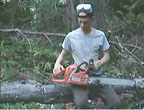May 09, 2006
Practical Performances In The Wilderness
![]()
Parts I and II Now On DVblog.org
6 Chapters from the database DVD A Series of Practical Performances In The Wilderness - Summer 2005 are now up on DVBlog.org including "Digging for Chicory," "Doable," and "Home Economics."
A Series of Practical Performances In The Wilderness, Summer 2005 is a video performance work made in the woods and on rural back-lots. Performative chapters on the DVD include, Move This Rock, Waiting On Bob, DoAble, Home Economics, Sticks Like Snakes, Digging for Chicory, and Springwater Finale. This video is the first in a series of forthcoming performance-art videos by Peppermint & Nadir which engage issues, ideas, and mythologies of the American concepts of wilderness, space, the frontier, and humans’ ethical relation to animals, forestlands, and nature. View Chapters 1, 2, and 3; Chapters 4, 5, and 6 are here.

This project is part of Cary Peppermint and Christine Nadir’s series of performance-art videos begun in 2002. Peppermint is an artist who works with new media technologies to create networked environments incorporating the internet, physical installations, experimental music and sound, and live performance. Until recently, Cary directed the Digital Art and Design program of Hartwick College, and in Fall 2006 he will assume the digital media position at Colgate University's Department of Art and Art History. Christine Nadir teaches literature at State University of New York College at Oneonta and is a doctoral candidate at Columbia University where she is completing her dissertation. Its working title is “The Future of the World: Sacrifice, Economy, and Ethics in Environmental Literature and Ecocriticism.”
Christine feels that these videos capture some of the energy, activities, and thoughts that she and Cary have experienced as New Yorkers living in the wilderness for four months every year: trying to establish a functional home without running water, electricity, or maintained roads; developing relationships with locals; un-learning the romanticization of nature while re-learning humanity’s dependence on the environment for survival; and researching the details of the history of the land and the surrounding area (its previous deforestation, its logging, its near use for an auto salvage yard, its use as farmland and grazing ground one hundred years ago, the precolonial possession by Native Americans for centuries before that).
Cary says: The North American concepts of wilderness are informed by nationalist ideologies and concepts of freedom as a wild, un-checked frontier of possibility. I don’t believe there is any such thing as wilderness as we Americans are inclined to see it. How could one know or understand that which is truly wild much less employ it toward nation-building? Also, I find a certain intellectual humor in the offering of performances that purport to be both practical and wild.
Posted by jo at May 9, 2006 12:48 PM
